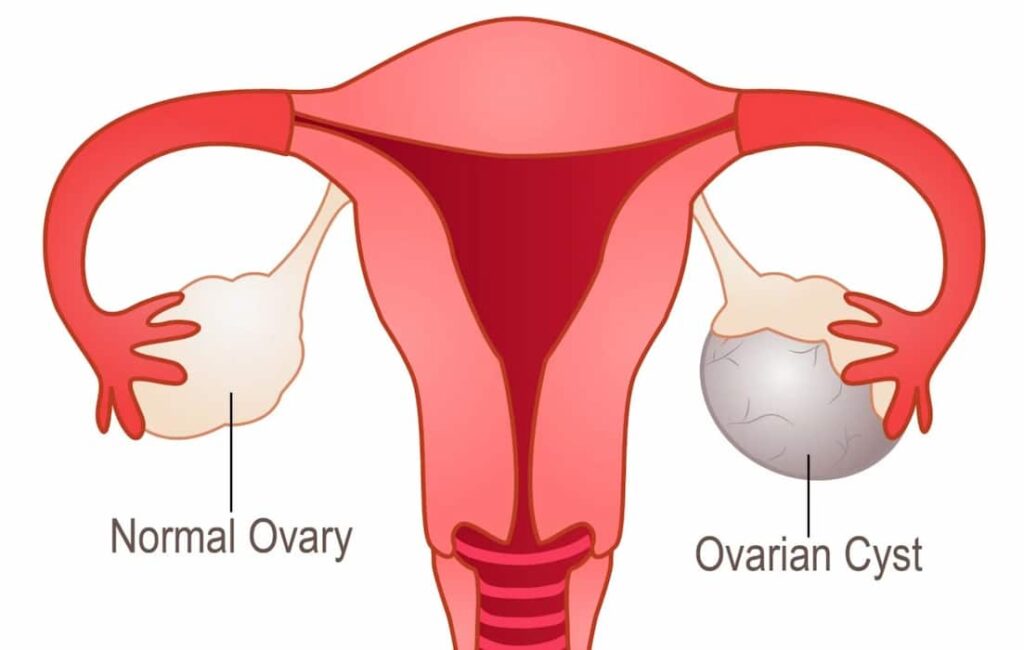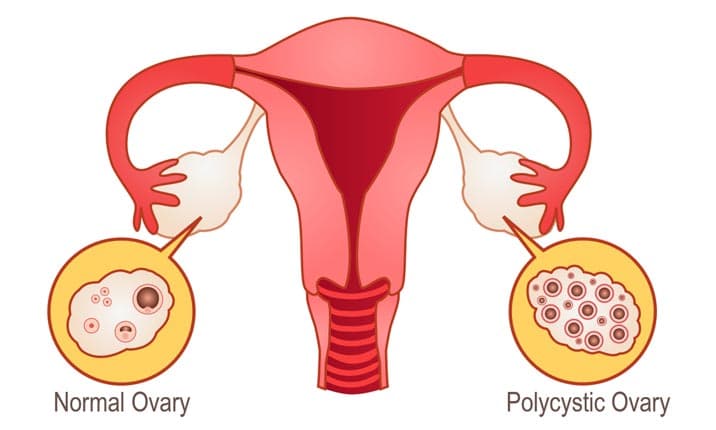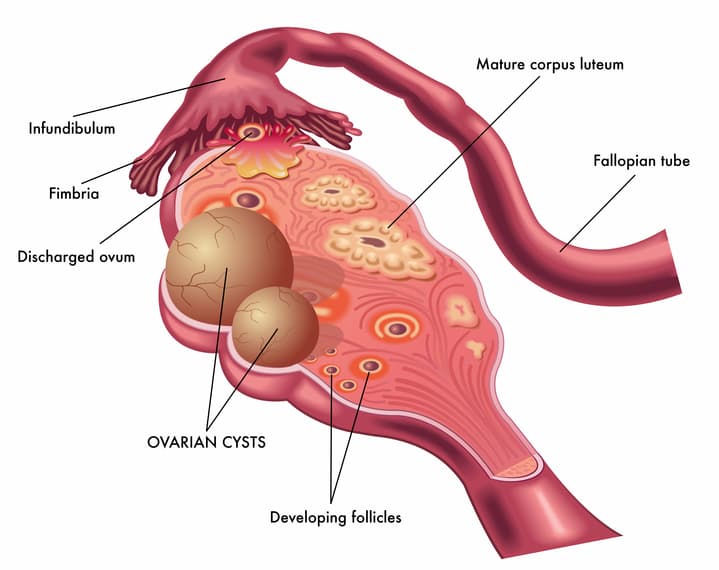Will I Lose Weight When They Remove Ovarian Cyst?
Ovarian cysts are sacs containing fluid that can form inside or on the surface of the ovary.
Ovarian cysts can occur in women of any age.
While some ovarian cysts cause symptoms such as pain or pressure in the pelvic region, other patients have no symptoms.
Irregularities in menstrual periods are not usually related to ovarian cysts.
Most ovarian cysts are not cancerous and do not need to be surgically removed.
The size of the cysts may be less than one centimeter and in some cases even larger than 10 centimeters.

What Will We Learn?
Will I Lose Weight When They Remove Ovarian Cyst?
This depends on the size of the cyst in your ovary.
If the cyst in your ovary is large and heavy, you may experience weight loss when it is surgically removed.
In 2018, doctors removed a 50-pound cyst from a woman named Kayla Rahn in Alabama.
Yes. This is not a joke. Exactly 50 kilos.
Doctors confused Kayla Rahn’s illness with pregnancy.
Officials at Jackson Hospital in Montgomery performed the surgery successfully and said Rahn had a mucinous cystadenoma, a benign cystic tumor of the ovary.
Rahn said he lost 75 kilos because of the cyst.
It should be noted that the probability of such disorders occurring in other people is very low.
When you go for the exam, your doctor will tell you how big or how small the cyst is.
In most cases, the cyst on the ovary of women is small.
It should be noted that the removal of a small size cyst does not always lead to weight loss results.
If you are worried about weight problems, it would be better to discuss this with your doctor.
After a real examination, your doctor will answer all your questions.
Why Do Ovarian Cysts Occur?
The reasons for the formation of ovarian cysts differ in menopausal and non-menopausal people.
The most common causes of ovarian cysts in non-menopausal women are:
- Ovulation – Functional ovarian cysts form when a follicle (sac) grows but does not rupture to release the egg. These cysts usually resolve without treatment.
- Dermoid cysts – Dermoid cysts (teratomas) are one of the most common types of cysts in women between the ages of 20 and 40. A dermoid cyst consists of ovarian germ cells and may contain teeth, hair, or fat. Most dermoid cysts are benign, but these cysts may rarely be cancerous.
- Polycystic ovary syndrome (PCOS) – Patients with polycystic ovary syndrome may have many small cysts. These cysts do not need to be surgically removed or treated with medication, but women with PCOS may need treatment for other PCOS problems, such as irregular menstrual periods.
- Endometriosis – Women with endometriosis may develop a type of ovarian cyst called an endometrioma or “chocolate cyst”.
- Pregnancy – An ovarian cyst normally develops early in pregnancy to help support the pregnancy until the placenta forms. In some cases, the cyst remains in the ovary until later in pregnancy.
- Severe pelvic infections – Severe pelvic infections can spread and involve the ovaries and fallopian tubes. As a result, pus-filled cysts form near the ovaries or fallopian tubes.
- Cancer – Cancer is a relatively rare cause of ovarian cysts in premenopausal ( women. Less than 1 percent of growths on or near the ovary are related to ovarian cancer. The most common causes of ovarian cysts in postmenopausal women whose menstrual periods have stopped are noncancerous growths and fluid collection in the ovaries.
In postmenopausal women, new growths on or around the ovary are slightly more likely to result from cancer than in premenopausal women.

Am I Ovarian Cancer?
While ovarian cancer is not the most common cause of ovarian cysts, many women diagnosed with cysts worry that they may have cancer.
Ovarian cancer is more likely in women who have:
- Genetic predisposition to ovarian cancer (eg, family history of ovarian or related cancer)
- History of breast or gastrointestinal cancer
- A complex-looking cyst (solid areas, a nodule on the surface, or a cyst with multiple fluid-filled areas)
- Fluid collection in the pelvis or abdomen during the imaging test (called ascites)
However, these conditions can also be seen in women who do not have cancer.
In most cases, more tests will be needed to measure the likelihood of cancer.
If your doctor is worried that you may have ovarian cancer, a gynecological oncologist may recommend that you see a specialist.
These doctors are people who have received training in the surgical treatment of ovarian cancer, which can increase the success of the treatment.
You can read this article to learn about how to perform ovarian cyst surgery.
Ovarian Cyst Symptoms
While ovarian cysts can cause symptoms, they do not show any symptoms in some cases.
Women with symptoms from ovarian cysts typically feel pain or pressure in the lower abdomen on the side of the cyst.
This pain may be dull or sharp.
It can go on continuously or come and go.
Pain in the lower abdomen with cramps is not usually related to ovarian cysts.
If an ovarian cyst ruptures, a person may experience a sudden sharp pain that can be severe.
During torsion (twisting) of an ovary, women may experience pain along with nausea and vomiting.
Abnormal menstrual periods or vaginal bleeding are not usually related to ovarian cysts.
How Is Ovarian Cyst Diagnosed?
Diagnosis of ovarian cysts is usually carried out during a pelvic exam.
However, an imaging test, such as a pelvic ultrasound, is usually necessary to confirm the diagnosis.
Computed tomography or magnetic resonance imaging (MRI) can also be used for diagnosis, although less frequently than ultrasound.
These imaging tests can provide information about the size, location, and other important features of the cyst.
Blood Tests For The Diagnosis Of Ovarian Cyst
One or more blood tests may be recommended if you have an ovarian cyst. Blood tests can help determine the nature of the cyst.
Pregnancy Test
Premenopausal women with ovarian cysts usually have a blood or urine pregnancy test done.
Ovarian cysts are common during pregnancy.
Cancer Antigen 125 (CA 125)
CA 125 is a blood test performed on women with ovarian cysts.
However, the results of the CA 125 test alone are not sufficient to diagnose ovarian cancer.
Many women with early ovarian cancer have normal CA 125 levels.
CA 125 is elevated to abnormal levels in about 80 percent of women with advanced ovarian cancer.
In addition, many conditions other than cancer can cause elevated CA 125, including endometriosis, uterine fibroids, pelvic infections, heart failure, and liver and kidney disease.
As a result, measurement of CA 125 is not recommended in all circumstances.
The CA 125 test is often recommended for postmenopausal women with ovarian cysts.
CA 125 may be recommended to premenopausal women with very large ovarian cysts on ultrasound or suspected cancer.
CA 125 is generally not recommended in premenopausal women with small and unsuspected ovarian cysts.
Other blood tests are also available to look for the risk and presence of ovarian cancer in women with ovarian cysts.

Treatment In Ovarian Cysts
Depending on the results of the imaging test, your age, symptoms, blood test results, and family history, your doctor may recommend observation or surgery without treatment.
Ovarian cysts do not always require treatment.
In premenopausal women, ovarian cysts usually resolve on their own within one to two months without treatment.
In postmenopausal women, however, ovarian cysts are less likely to resolve without treatment.
If a cyst is large, causes pain, or appears suspicious for cancer, treatment usually requires surgery to remove the cyst or the entire ovary.
Observation Without Treatment
Premenopausal women
In premenopausal women, observation without treatment usually includes monitoring for symptoms (pelvic pain or pressure) and repeating a pelvic ultrasound six to eight weeks later.
If the ovarian cyst does not enlarge or resolve during the observation period without treatment, it usually does not need to be surgically removed.
Some premenopausal women are advised to take a birth control pill during this time to help prevent new ovarian cysts from developing.
If a cyst shrinks or does not change in size, the ultrasound is usually repeated at regular intervals until your doctor is sure the cyst is not growing.
If the cyst disappears, no further testing or follow-up is required.
Postmenopausal Women
In postmenopausal women, monitoring without treatment depends on ultrasound and cancer antigen 125 [CA 125] results.
If the cyst does not appear to be cancerous, observation without treatment may be an option and follow-up with pelvic ultrasound and measurement of CA 125 every three to six months for one year or until the cyst resolves.
However, ovarian cysts in postmenopausal women do not always resolve spontaneously.
If CA 125 levels rise or the cyst becomes larger or changes in appearance, surgery to remove the cyst may be recommended.
Ovarian Cyst Surgery
Surgery may be recommended in the following situations:
- If the cyst causes persistent pain or pressure, or if the cyst is at risk of tearing or twisting.
- If an ultrasound showed a cyst from endometriosis and was removed for fertility reasons.
- Large cysts do not mean that the cyst is cancerous. However, large cysts of 5 to 10 cm in size may be the reason for surgery.
- Your doctor may recommend surgery if the cyst is suspected to be cancer, if you have risk factors for ovarian cancer, or if the cyst looks potentially cancerous on imaging tests.
- If the suspicion of ovarian cancer is low but the cyst does not disappear after a few ultrasounds, you may prefer to have the cyst surgically removed after consulting your doctor.
- If surgery is required to remove an ovarian cyst, whether the surgery involves removal of just the cyst or the entire ovary depends on your age and other reasons.
For example:
● If cancer is suspected, the entire ovary should be removed, as cutting the cancerous tissue will increase the risk of cancer spreading. Removal of one of your ovaries will not cause you to go through menopause and infertility.
● If the cyst does not appear to be cancerous and can be removed with small incisions, it can be removed laparoscopically (with a few small incisions) through closed surgery and you can go home the same day.
● If the cyst is large or cancer is suspected, an open incision (called a laparotomy) may be required and the surgeon may need to remove the entire ovary and surrounding tissue. After a laparotomy, you will need to stay in the hospital for one or more nights.
Follow-up In Ovarian Cysts
After the ovarian cyst has resolved, you will not need any further imaging tests if your symptoms have disappeared.
Some ovarian cysts are more likely to recur than others.
This includes endometriomas and functional ovarian cysts.
If you are premenopausal and are worried about recurrent cysts, you can try to prevent the development of ovarian cysts by using the birth control pill or another hormonal birth control method with the advice of your doctor.
You can also read this article if you have watery discharge.
